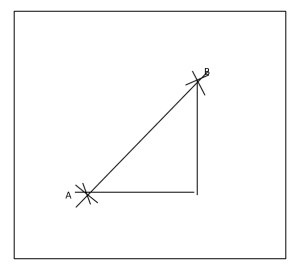What does differentiation mean?
Differentiation is a mathematical term used for calculating the rate of change; it is a fundamental concept of calculus. Differentiation is a process of finding the derivative of a function f(x) concerning x. For example, the speed of a train is calculated as the rate of change of distance concerning time.
Differentiation Calculator
A differentiation calculator is also known as a derivative calculator. It is an online tool that helps to differentiate a function and find its derivative. Differentiation is the mathematical term used for calculating the rate of change in a quantity with another quantity.
Working of Differentiation Calculator
By using the concept of differentiation one can find the slope of a line or a curve. The maximum and minimum values of various functions can be determined by differentiating them.
If there is a differentiable function y = f(x), then f'(x) or dy/dx is used for representing the first-order derivative. It means that the function is continuous but always the continuous function is not differentiable.
For computing the derivative of a function using limits, one can apply the first principle of differentiation. The formula is given as:
f’ (x) = lim▲x→0 f(x+▲x ) – f(x) / ▲x
By using this formula a differentiation formula can be derived which can be applied to elementary functions. This is given as
If f(x) = xn
Then,
f’ (x) = nxn-1
The geometrical meaning of the derivative of m = p(z) is the slope of the tangent to the curve m = p(z) at {z, p(z)}. The first principle of differentiation is to compute the derivative of the function using the limits.
Let a function of a curve be m = p(z)
Let’s take a point A with coordinates {z, p(z)} on a curve.
Take another point B with coordinates {z+h, p(z+h)} on the curve.
Now, AB is the secant t the curve.
The slope of a curve at a point is the slope of the tangent line at the point.
Therefore, the slope of the secant line is (m2 – m1 / z2 – z1)
Slope = ▲m / ▲z
= p(z + h) – p(z) / (z + h) –z
= p(z + h) – f(z) / h
h needs to be small as possible to get the slope of the tangent.
There is already, m = p(z)
There is an incremental change in z, denoted as ted as ▲z.
Then there exists an incremental change in m, denoted as ▲m.
Then m + ▲m = f(z + ▲z)
P(z) + ▲m = p(z + ▲z)
▲m = p (z + ▲z) – f(z)
Dividing by ▲z on both the sides,
dm/dz = p (z + ▲z) – p(z) / ▲z
By applying the limits one get
dm/dz = limδ→0 δm/δz
= limδz→0 f(z+δz) – f(z)/δz
Where d/dz is the differential coefficient, and it is known as the Leibnitz symbol.
Lim h→0 p (z + h) – p (z) / h,
If the limit exists p’ (z) is the first derivative of p(z). This derivative of p(z) quantifies the change in p(z) concerning z. This process is called differentiation.
Differentiation Example:
Examples of differentiation are –
Evaluate
- i) limx→π/2 (sinx)tanx
Solution,
Let y = limx→π/2 (sin x)tanx
Log y = limx→π/2 tanx log sinx
= limx→π/2 log sinx/cotx
= limx→π/2 (1/sinx) cosx/-cosec2x
Limx→π/2 (sinx cosx) = 0
Therefore, y = e0 =1
- ii) If U = log(x3+y3+z3– 3xyz) Then find the value of δU/δx + δU/δy + δU/δz
Solution,
δU/δx = 1/x3+y3+z3-3xyz(3x2 –3yz)
δU/δy = 1/x3+y3+z3-3xyz(3y2 –3xz)
δU/δz = 1/x3+y3+z3-3xyz(3z2-3xy)
∴δU/δx + δU/δy+ δU/δz = 3(x2+y2+z2)- 3(zy+yz+zx)/x3+y3+z3-3xyz
= 3(x2+y2+z2-zy+yz+zx)/(x+y+z)(x2+y2+z2-zy+yz+zx)
∴ δU/δx + δU/δy + δU/δz = 3/x+y+z
Partial Derivative Calculator
The process of obtaining the partial derivatives of a function is known as partial differentiation. A partial Derivative Calculator is an online tool that helps to differentiate its function and obtain its partial derivatives. The partial derivative is used in differential geometry and vector calculus.
Working of Partial Derivative Calculator
Partial differentiation can be used when the given function is in terms of two or more variables. In the case of partial differentiation, one can differentiate the given function concerning one variable while the other variables are treated as constants. Let’s assume a function that depends on two variables m and z given and p(m, z). The steps to find the partial derivatives of this function are:
- One needs to differentiate the function concerning z. The term containing the m variable is constants. The partial derivative of a function concerning z is denoted pz, pz, δzp or δp/δz.
- Now, one needs to differentiate the function concerning m. The terms with the z variable will be treated as constants. Then the partial derivative of a function concerning m is denoted pm, pm, δm p or δp/δm.
The formula of partial derivatives of a function is given as follows:
Pz = δp/δz = limh→0 p(z + h,m) – f(z,m)/h
Pz = δp/δm = limh→0 p(z,m + h) – p(z,m)/h
Conclusion
This is to conclude that differentiation is a mathematical term used for calculating the rate of change; it is a fundamental concept of calculus. Differentiation is a process of finding the derivative of a function f(x) with respect to x. For example, The speed of a train is calculated as the rate of change of distance with respect to time.
 Profile
Profile Settings
Settings Refer your friends
Refer your friends Sign out
Sign out





